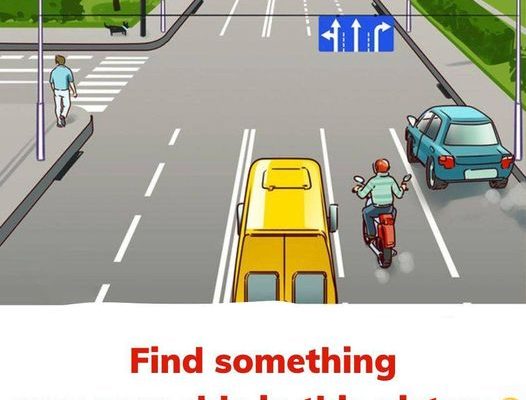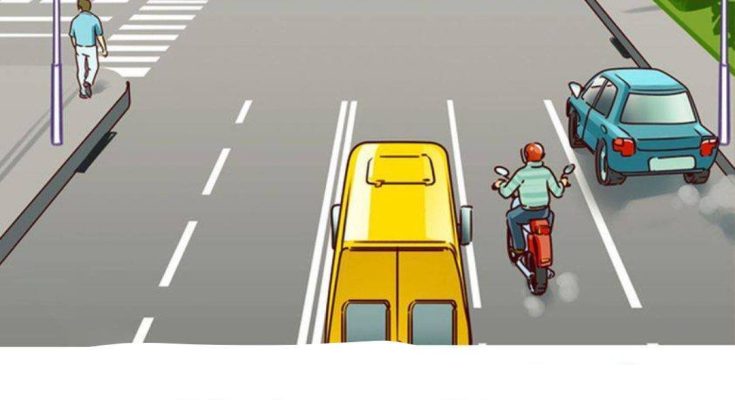Find the mistake in the picture?
Do you have an eye for detail? This intriguing picture puzzle invites you to take a close look at what seems to be an ordinary street scene. It features a traffic sign, a few cars, and some pedestrians, all going about their business. But something in this image doesn’t quite add up. Are you able to spot the subtle mistake that most people overlook? Challenge yourself to find it and sharpen your observation skills in the process.

Why Spot-the-Difference Puzzles Are Great for the Brain
Spot-the-difference puzzles and visual challenges are fantastic exercises for enhancing your attention to detail. These puzzles often require you to look beyond the obvious, focusing on tiny details that can easily be missed. Whether it’s a misplaced object, an unusual sign, or a subtle misalignment, these errors can catch you off guard if you’re not looking closely. Not only are these puzzles fun, but they also help improve your focus and ability to notice inconsistencies.
So, are you ready to find the error in this image? Let’s break down the puzzle and examine each element closely to uncover the hidden mistake.
Common Pitfalls in Solving Visual Puzzles
Before we dive into this puzzle, it’s helpful to understand some common mistakes people make with visual puzzles like this one. Here are a few things to watch out for:
- Focusing Too Much on Main Elements: People often zero in on the most prominent parts of the image, like vehicles or pedestrians, and miss smaller, less noticeable details.
- Overlooking Background Clues: The background of the image frequently contains important clues. In this puzzle, pay attention to road signs, lane markings, and surrounding areas.
- Making Assumptions: Our brains tend to fill in gaps based on what we expect to see. For example, if you see a sign indicating a turn, you might automatically assume there’s a road to turn onto. But in these puzzles, these assumptions can lead you astray.
Keeping these pitfalls in mind, let’s tackle the puzzle step-by-step to find the error.
Step-by-Step Guide to Solving the Puzzle
1. Examine the Road Markings and Signs
First, take a close look at the lane markings and traffic signs. In this image, you’ll notice three lanes with arrows indicating different directions: left, straight, and right. The far-right lane has an arrow that points right, suggesting it’s intended for a right turn. But here’s where you need to pay attention – is there actually a road to the right?
2. Analyze the Right-Turn Sign
Now, focus on the right-turn sign. This sign is above the far-right lane, which directs traffic to turn right. However, when you trace the path to the right, it leads to a curb and greenery instead of an actual road. This detail is crucial; the sign suggests a turn, yet the layout of the street doesn’t match up. This is a strong indication that something is amiss.
3. Look for Contradictions
Compare the traffic sign’s instructions with the street layout. While there are clearly marked lanes for turning left and going straight, the right-turn arrow doesn’t seem to match reality. If a vehicle followed the sign’s direction, it would head straight into a curb, as there’s no road or pathway to the right. This contradiction is a common tactic in visual puzzles, which are designed to test your ability to spot inconsistencies.
4. Identify the Mistake
After carefully examining the sign and lane markings, you can conclude that the right-turn sign is the mistake in this image. It’s misleading because there’s no actual road for vehicles to turn onto. Instead, the sign points toward a solid curb and greenery, making the right-turn arrow pointless. This is the subtle yet significant error hidden in the scene.
Breaking Down the Solution
The solution to this puzzle lies in the disconnect between the right-turn sign and the actual layout of the street. While the sign instructs drivers to turn right, there’s nowhere for them to go in that direction. This small but impactful detail disrupts the logical flow of the road markings and signage, making it the hidden error in the image. Visual puzzles often use this kind of inconsistency to challenge your perception and force you to question your assumptions.

Challenge Your Friends to Find the Mistake
Now that you’ve solved this puzzle, why not challenge a friend or family member to try it? Visual puzzles are not only a great way to test your skills but also a fun way to engage with others. See if they can spot the mistake and discuss how you each approached the puzzle. You might be surprised by how different your perspectives are!
Conclusion: A Fun Exercise for a Sharper Mind
Visual puzzles like this one offer more than just entertainment. They help you develop a keen eye for detail, boost your critical thinking skills, and challenge your brain in a way that everyday life often doesn’t. So, next time you come across a spot-the-difference puzzle or a visual challenge, take your time, enjoy the process, and remember – the smallest details often hold the biggest surprises. Keep practicing, and you’ll find yourself spotting errors that others might miss. Happy puzzling!




